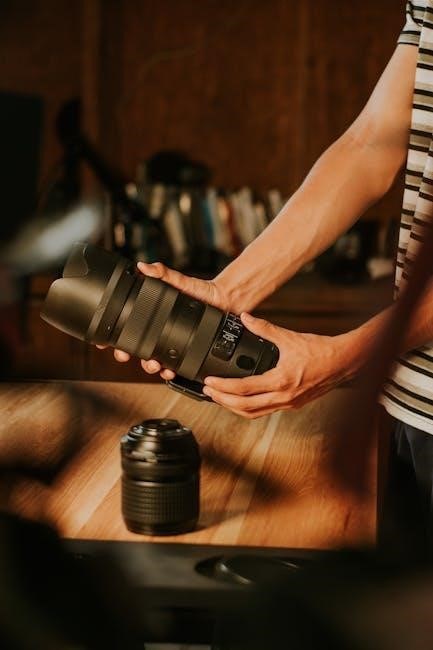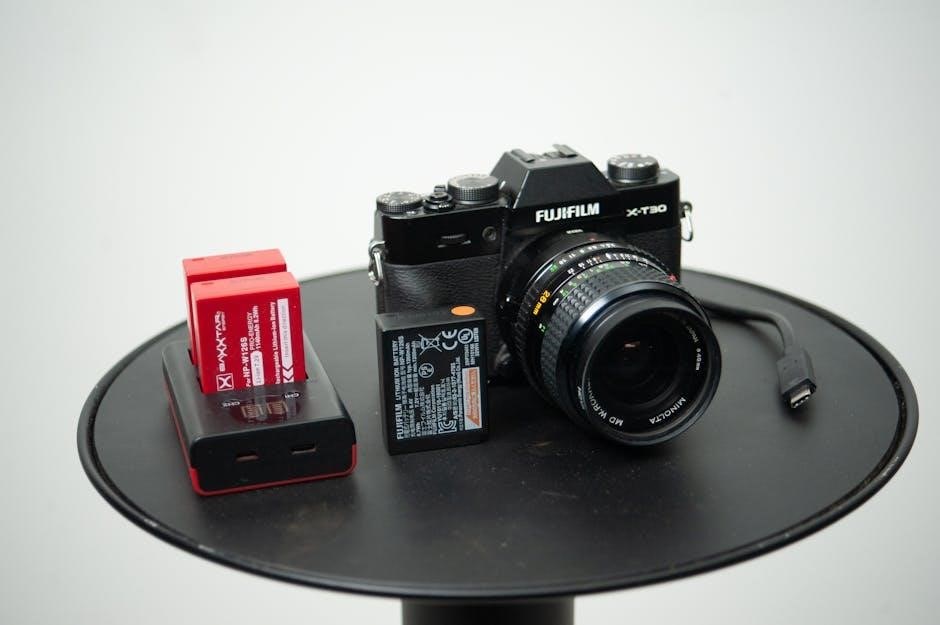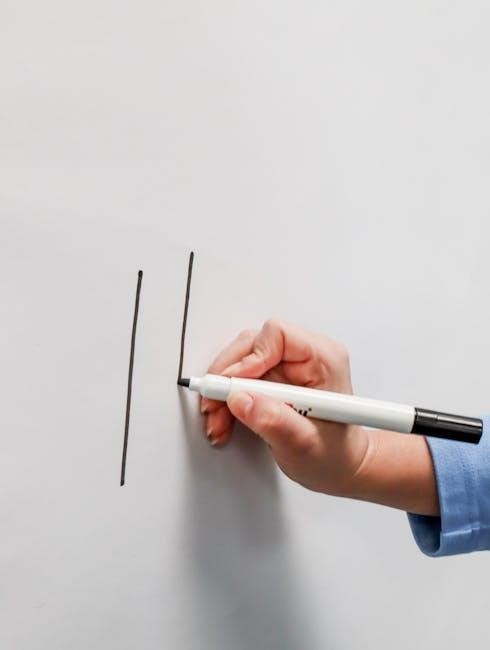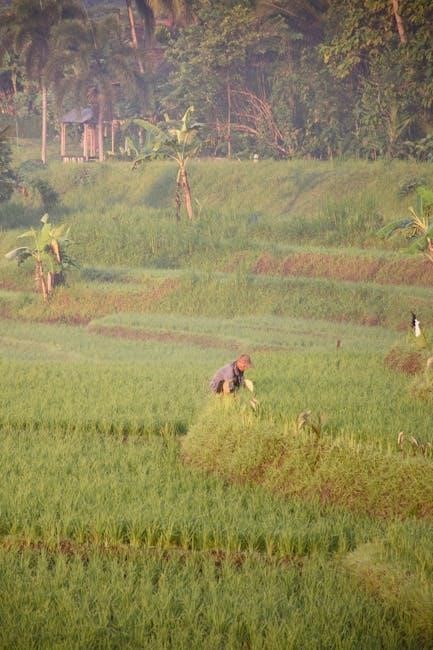The Nikon D7200 is a high-performance DSLR camera designed for enthusiasts and professionals, offering a 24.2MP CMOS sensor, EXPEED 4 processor, and exceptional low-light performance. This guide provides detailed instructions for mastering its features and settings.
Features and Specifications
The Nikon D7200 is a powerful DSLR camera featuring a 24.2MP APS-C CMOS sensor and the EXPEED 4 image-processing engine, delivering outstanding image quality and performance. It offers a wide ISO range of 100-25600, expandable to 51200, ensuring excellent low-light photography. The camera is equipped with a 51-point autofocus system, providing precise and fast subject tracking. It supports 1080p Full HD video recording at 60fps and features built-in Wi-Fi and NFC for seamless connectivity. The D7200 also includes a 3.2-inch LCD screen with 1,228,800 dots for clear image preview and playback. Weather-sealing ensures durability in harsh conditions, making it ideal for outdoor photography. With a continuous shooting speed of up to 6fps, it captures dynamic action effortlessly. The camera supports a variety of file formats, including RAW, JPEG, and MOV, offering flexibility for post-processing. These features make the Nikon D7200 a versatile tool for both enthusiasts and professionals, suitable for various photographic genres and applications.
First-Time Setup and Initial Configuration
Before using your Nikon D7200, follow these steps for proper setup. Begin by unboxing and inspecting the camera and accessories, including the battery, charger, and memory card. Charge the battery fully using the provided charger. Insert the battery into the camera, ensuring it is securely locked in place. Next, insert a memory card into the slot, making sure it clicks into position; Attach the provided lens by aligning the mounting indexes and rotating it clockwise until it locks. Turn on the camera using the power switch located on the top right. Navigate through the initial setup menu using the “OK” button and multi-selector to set the language, date, time, and other preferences. Set the shooting mode to “Auto” for beginners or “Manual” for advanced users to start capturing images. Finally, review the camera’s ergonomic design and familiarize yourself with key controls such as the mode dial, command dials, and AF-mode button. This setup ensures you are ready to begin exploring the camera’s capabilities.

Safety Precautions and Handling Tips
To ensure safe and effective use of your Nikon D7200, follow these guidelines. Always use Nikon-certified accessories to avoid damage or malfunction. Avoid exposing the camera to water, extreme temperatures, or direct sunlight for prolonged periods. Handle the camera and lens with care to prevent scratches or drops. Store the camera in a dry, cool place when not in use. Clean the lens and body regularly using a soft, dry cloth or a specialized cleaning kit to maintain image quality. Avoid touching the camera’s internal components, as oils from your skin can damage sensitive parts. For optimal performance, use only compatible memory cards and batteries. When handling the battery, ensure it is inserted correctly to prevent electrical issues. Additionally, protect the LCD screen and viewfinder from excessive light or impact. By adhering to these precautions, you can extend the lifespan of your Nikon D7200 and ensure it performs at its best.
Included Accessories and Optional Equipment
Your Nikon D7200 comes with essential accessories to get you started. These include the EN-EL15 rechargeable lithium-ion battery, a battery charger (MH-25a), a USB cable (UC-E23), a camera strap (AN-4Y), and a body cap (BF-1B). Additionally, a printed user manual and warranty information are provided. For enhanced functionality, consider optional equipment such as Nikon-certified lenses, external flash units, and wireless remote controllers. Memory cards, such as SD, SDHC, or SDXC cards, are required for storage and must be compatible with the camera’s specifications. A tripod or monopod can improve stability for low-light or long-exposure shots. Nikon also offers optional grips and battery packs for extended shooting sessions. Always ensure that any third-party accessories are compatible with your camera to maintain performance and avoid damage. Using Nikon-certified products guarantees optimal functionality and preserves your camera’s warranty. Explore these options to customize your D7200 setup according to your photography needs.

Understanding the Camera’s Construction
The Nikon D7200 features a durable magnesium alloy body with weather-sealing for dust and moisture resistance, ensuring robust performance in challenging conditions. Its ergonomic design provides a comfortable grip for extended shooting sessions.

Exterior and Interior Components
The Nikon D7200 features a robust exterior constructed from magnesium alloy, ensuring durability and weather-sealing for protection against dust and moisture. The camera’s ergonomic design includes a comfortable grip, intuitive controls, and a mode dial on the top plate for easy access to shooting modes. The exterior also houses a variety of ports, including USB, HDMI, and audio jacks, for expanded connectivity.
Inside, the D7200 is equipped with a 24.2MP APS-C CMOS sensor and the EXPEED 4 image processor, delivering high-quality images and fast performance. The camera’s internal components are optimized for efficiency, with advanced autofocus and metering systems. The shutter mechanism is durable and designed for long-term reliability, while the memory card slots support SD, SDHC, and SDXC cards, including UHS-I for faster data transfer. The D7200 also includes built-in Wi-Fi and NFC for seamless connectivity to smartphones and tablets, enabling easy image transfer and remote shooting through the Nikon SnapBridge app.
Lens Mount and Compatible Lenses
The Nikon D7200 utilizes the Nikon F-mount, a widely-used lens mount system that supports a broad range of interchangeable lenses. This compatibility allows photographers to choose from a vast selection of lenses, including AF-S, AF-P, and even older manual-focus lenses. The camera is particularly optimized for use with Nikon’s DX-format lenses, which are designed to match the APS-C sensor size of the D7200. However, it also supports FX-format lenses, offering flexibility for photographers who own a mix of lens types. For the best performance, Nikon recommends using lenses with built-in autofocus motors, such as AF-S and AF-P models, as these enable faster and quieter focusing. Additionally, third-party lenses from brands like Tamron, Sigma, and Tokina are compatible, provided they are designed for the Nikon F-mount. Always ensure that lenses are properly mounted and aligned to avoid damage to the camera or lens. Regular cleaning and maintenance of the lens mount are also recommended for optimal performance.
LCD Screen and Viewfinder
The Nikon D7200 features a 3.2-inch, 1,228,800-dot LCD screen that provides crisp and detailed image playback, menu navigation, and live view shooting. The screen is fixed in place, offering a clear view even in bright lighting conditions. For precise composition, the camera is equipped with an optical pentaprism viewfinder, offering 100% frame coverage and a magnification of approximately 0.94x. This allows photographers to see exactly what the sensor captures, ensuring accurate framing and focus. The viewfinder also displays essential shooting information, such as aperture, shutter speed, and ISO, keeping you informed without needing to look away from your subject. A diopter adjustment control is provided for users with vision impairments, ensuring a sharp viewfinder image. Additionally, the viewfinder incorporates a grid display option, which can be enabled via the camera’s menu system to assist with composition. The combination of a high-quality LCD and a precise viewfinder makes the D7200 an excellent tool for both still photography and video recording.
Memory Card Slots and Storage Options
The Nikon D7200 is equipped with two SD card slots, allowing for versatile storage solutions. Both slots support SDXC and UHS-I cards, enabling high-speed data transfer and ample storage capacity. Users can configure the dual slots to store images in various ways, such as overflow recording, where images are saved to the second card when the first is full, or separate storage of RAW and JPEG files. The camera also supports Eye-Fi cards for wireless image transfer to compatible devices. For optimal performance, it is recommended to use high-speed memory cards, especially when shooting in burst mode or recording video. The memory card slot cover is located on the right side of the camera and is secured with a latch to protect against dust and moisture. Before use, memory cards must be formatted in the camera to ensure compatibility and proper function. This feature ensures efficient and reliable storage management for photographers.

Basic Photography Modes and Settings
The Nikon D7200 offers multiple shooting modes, including Auto, Scene, Manual, Aperture Priority, and Shutter Priority. These modes provide flexibility for various photography situations, allowing users to control exposure settings like ISO, autofocus, and white balance.
Auto Mode and Scene Modes
The Nikon D7200 features Auto Mode, which simplifies photography by automatically adjusting settings for optimal results. Scene Modes, such as Portrait, Landscape, and Night Portrait, cater to specific shooting scenarios, ensuring ideal configurations for each situation. These modes are perfect for beginners or those seeking convenience, allowing them to capture high-quality images without manual adjustments. The camera analyzes lighting and subject type in Auto Mode to deliver sharp, well-exposed photos. Scene Modes further enhance creativity by tailoring settings to match the selected genre, making it easier to achieve professional-looking results. This versatility ensures that users can adapt to various photographic challenges effortlessly, leveraging the camera’s advanced technology to produce stunning imagery in any condition. The D7200’s intuitive design makes navigating these modes seamless, empowering photographers of all skill levels to explore their creative potential.
Manual Mode and Exposure Control
Manual Mode (M) on the Nikon D7200 grants photographers complete control over exposure settings, allowing precise adjustments to aperture, shutter speed, and ISO sensitivity. This mode is ideal for experienced users seeking creative freedom and customization. Exposure control is further refined through the use of the exposure compensation button, enabling subtle adjustments to brightness and contrast. The D7200’s 24.2MP CMOS sensor and EXPEED 4 image processor ensure high-quality results, even in challenging lighting conditions. Users can also leverage the camera’s metering system to assess light accurately and make informed adjustments. For advanced shooters, manual mode offers the flexibility to experiment with unique styles and effects. By mastering manual exposure control, photographers can unlock the full potential of the D7200, capturing images that reflect their artistic vision. This mode is particularly useful in studios, landscapes, or scenarios requiring precise control over lighting and composition.
Aperture Priority and Shutter Priority Modes
Aperture Priority (A/Av) and Shutter Priority (S/Tv) modes on the Nikon D7200 offer photographers semi-automatic control over exposure, balancing creativity with ease of use. In Aperture Priority, users set the aperture, and the camera automatically adjusts the shutter speed to maintain proper exposure. This mode is ideal for controlling depth of field, allowing for creative effects like blurring backgrounds or keeping landscapes sharp. Shutter Priority, conversely, lets users set the shutter speed, with the camera adjusting the aperture. This is perfect for capturing motion, such as freezing fast-moving subjects or creating artistic blur. Both modes provide flexibility for those who want to influence specific aspects of their photos without managing all settings manually. The D7200’s advanced metering system ensures accurate exposures, even in challenging lighting conditions. These modes are particularly useful for photographers transitioning from auto modes to more manual control, offering a stepping stone toward full creative freedom.
Understanding ISO Sensitivity and Noise Reduction
ISO sensitivity on the Nikon D7200 determines how responsive the camera’s sensor is to light. Lower ISO values (e.g., ISO 100) are ideal for bright conditions, capturing sharp images with minimal noise. Higher ISOs (e.g., ISO 6400) are used in low-light scenarios but may introduce digital noise, which can degrade image quality. The D7200 features an expanded ISO range up to 25600 (black and white only), making it versatile for various lighting conditions. Noise reduction settings help mitigate grain in high-ISO images, though excessive reduction can soften details. Users can adjust noise reduction levels or disable it for RAW shooting, allowing post-processing flexibility. Balancing ISO and noise reduction is crucial for achieving optimal image quality, especially in challenging lighting environments.

Advanced Shooting Techniques
Master advanced techniques with the Nikon D7200, including autofocus tracking, burst shooting, and white balance control. These features enhance your photography skills, capturing dynamic moments with precision and creativity.

Autofocus Modes and Focus Tracking
The Nikon D7200 offers advanced autofocus modes, including Single AF, Continuous AF, and AF-C, designed for precise subject tracking. The camera’s 51-point AF system ensures sharp focus even with fast-moving subjects. Use the AF-C mode for dynamic action shots, while Single AF is ideal for stationary subjects. Customize focus tracking by adjusting settings like focus priority and release timing. The D7200 also supports 3D Tracking, allowing seamless focus shifts between subjects. For enhanced control, assign focus modes to customizable buttons for quick access. These features make the D7200 versatile for various photography genres, from wildlife to sports. Properly configuring autofocus settings ensures optimal performance, making it easier to capture sharp, professional-quality images consistently.
Metering Modes and Exposure Compensation
The Nikon D7200 offers multiple metering modes to ensure accurate exposure: Matrix, Center-Weighted, and Spot. Matrix metering analyzes the entire scene for balanced results, while Center-Weighted prioritizes the central area. Spot metering measures a specific point, ideal for high-contrast situations. Exposure compensation allows adjustments of ±5 EV in 1/3 or 1/2 EV increments, enabling fine-tuned brightness control. Active D-Lighting enhances detail in shadows and highlights, while bracketing captures multiple exposures for later merging. These tools provide flexibility in various lighting conditions, ensuring optimal image quality. By mastering metering modes and exposure compensation, photographers can achieve professional-level control over their shots, adapting to any situation with precision and creativity.
White Balance and Color Temperature
White balance on the Nikon D7200 ensures accurate color representation by adjusting to lighting conditions. The camera offers multiple presets, including Auto, Daylight, Fluorescent, Incandescent, Cloudy, and Shade, to match various environments. Additionally, the Set White Balance option allows manual measurement of a neutral object for precise customization. Fine-tuning is also possible, enabling adjustments to color temperature in 10-Kelvin increments for personalized results. The camera supports up to four custom white balance settings, which can be saved for quick access. Color temperature ranges from 2,500K to 10,000K, providing flexibility for creative control. These features, combined with the EXPEED 4 processor, deliver natural and vibrant colors in any lighting scenario, making the D7200 versatile for photographers seeking precise color accuracy and artistic expression. This functionality is particularly useful for capturing consistent tones in studio, outdoor, and mixed-light environments.
Burst Mode and Continuous Shooting
The Nikon D7200 excels in capturing dynamic moments with its robust burst mode and continuous shooting capabilities. It can shoot up to 6 frames per second (fps) in continuous high-speed mode, making it ideal for sports, wildlife, and action photography. When using the optional MB-D15 battery grip with EN-EL15 batteries, the frame rate increases to 7 fps. The camera also supports continuous low-speed shooting at 1-6 fps for more controlled capture. Additionally, the D7200 can shoot in Quiet Continuous mode, which reduces shutter noise, perfect for discrete photography. The camera’s buffer allows for up to 100 large/fine JPEGs or 27 14-bit RAW files in a single burst, ensuring extended shooting sessions without interruption. These features, combined with the EXPEED 4 processor, enhance the ability to freeze fast-moving subjects and capture fleeting moments with precision and clarity, making the D7200 a reliable choice for photographers demanding high-speed performance.

Playback and Reviewing Photos

The Nikon D7200 offers intuitive playback options, allowing you to review images on its 3.2-inch LCD screen. You can delete, protect, or retouch photos directly on the camera, enhancing your post-capture workflow efficiently.
Navigating the Playback Menu
The Playback Menu on the Nikon D7200 allows you to manage and enhance your photos directly on the camera. To access it, press the playback button and use the multi-selector to navigate through options like Delete, Protect, and Retouch. The OK button selects options, while the Zoom buttons let you enlarge or reduce image views. You can scroll through images using the multi-selector or the main command dial. For detailed editing, the Retouch menu offers options like trimming, applying filters, or adjusting color balance. The camera also supports slideshow creation with customizable intervals and transition effects. Use the Protect feature to prevent accidental deletion of important shots. Additionally, the Rotate Tall Images option ensures portrait-oriented photos are displayed correctly. This menu is essential for reviewing and organizing your photos efficiently before transferring them to a computer. By mastering these features, you can streamline your post-shooting workflow and make the most of your images.
Deleting and Protecting Images
To manage your photos effectively, the Nikon D7200 allows you to delete unwanted images or protect important ones. Press the Playback button to view your photos, then use the Multi-selector to navigate. To delete a single image, select the OK button and choose Delete. For multiple deletions, go to the Playback Menu, select Delete, and choose Selected Images or All Images. To protect images from accidental deletion, highlight the desired photo and press OK to apply the Protect feature. Protected images are marked with a padlock icon and cannot be deleted in normal playback modes. You can also use the Image Review feature to quickly delete photos immediately after shooting. Organizing your images into folders can further simplify the process of managing and protecting your files. This ensures your valuable memories remain safe while allowing you to efficiently remove unnecessary shots.
In-Camera Image Editing and Retouching
The Nikon D7200 offers a range of in-camera editing and retouching tools, allowing you to enhance your photos without transferring them to a computer. Access these features through the Playback Menu under the Retouch Menu option. Here, you can perform tasks like image rotation, resizing, and cropping. Additionally, the camera provides filters such as monochrome, sepia, and vignette effects to add creative touches to your images. For precise adjustments, the D7200 supports editing of RAW images directly in the camera, enabling you to fine-tune exposure, contrast, and color balance. Retouching options include red-eye correction and image overlay, allowing for minor corrections and artistic effects. To access these tools, navigate to the Playback Menu, select the Retouch Menu, and choose your desired option. This feature is particularly useful for photographers who want to refine their shots on the go, ensuring high-quality results without post-processing on a separate device.
Transferring Images to a Computer
Transferring images from your Nikon D7200 to a computer is a straightforward process that can be done using various methods. The most common method is via USB cable, where you connect the camera directly to your computer. Ensure the camera is turned off before connecting to avoid any damage or data loss. Once connected, the computer should recognize the camera as a removable storage device, allowing you to transfer files using your operating system’s file explorer or Nikon’s proprietary software, such as Nikon Transfer 2. Additionally, you can remove the memory card from the camera and use a card reader to transfer images, which is often faster and more convenient. For wireless transfer, the D7200 supports Wi-Fi connectivity, enabling you to send images to your computer or mobile device using Nikon’s SnapBridge app. Regardless of the method, always ensure your computer has the necessary software installed to handle the transfer and organize your photos efficiently.

Menu Guide and Navigation
The Nikon D7200’s menu system is accessed via the MENU button, offering intuitive navigation using the multi-selector. The Nikon Manual Viewer 2 app provides mobile access to the menu guide, while the PDF manual details all settings and customization options for seamless control.
Main Menu Overview
The Nikon D7200’s main menu is divided into user-friendly sections, including Playback, Shooting, Setup, and Retouch menus. Each menu offers specific functions to customize camera settings. The Playback menu allows reviewing and managing images, while the Shooting menu adjusts parameters like ISO, white balance, and autofocus modes. The Setup menu handles camera maintenance, such as formatting memory cards and updating firmware. Additionally, the Retouch menu provides in-camera editing options for enhancing photos. The Nikon Manual Viewer 2 app offers mobile access to the menu guide, ensuring easy navigation. The PDF manual details all menu options, enabling users to explore advanced features and personalize their camera settings effectively. This structured approach ensures that users can efficiently navigate and utilize the D7200’s capabilities to achieve optimal results in various shooting scenarios. The menu system is designed to cater to both beginners and experienced photographers, offering a comprehensive yet intuitive interface.
Custom Setting Menu
The Custom Setting Menu on the Nikon D7200 allows users to tailor camera operations to their preferences. This menu is divided into categories for easy navigation, including autofocus, metering, and bracketing options. It enables adjustments to settings like autofocus modes, metering patterns, and exposure bracketing. Users can customize controls such as assigning functions to specific buttons or adjusting the sensitivity of the autofocus. The menu also includes options for fine-tuning noise reduction and color balance. Detailed instructions for navigating and utilizing the Custom Setting Menu can be found in the PDF manual and the Nikon Manual Viewer 2 app. This feature is particularly useful for advanced photographers seeking to optimize the camera’s performance for specific shooting styles or conditions. By exploring the Custom Setting Menu, users can unlock the full potential of the D7200 and enhance their photography experience. This menu is a key tool for personalizing the camera to meet individual creative needs.
Shooting and Setup Menus
The Shooting and Setup Menus on the Nikon D7200 provide comprehensive control over camera functions, enabling users to optimize settings for various shooting scenarios. The Shooting Menu includes options for image quality, white balance, ISO sensitivity, and noise reduction. Users can select from RAW, JPEG, or RAW+JPEG formats and adjust settings like Picture Controls to customize image output. The Setup Menu allows for camera configuration, such as setting the time zone, language, and firmware updates. It also includes options for formatting memory cards, adjusting monitor brightness, and enabling features like Wi-Fi and Bluetooth for wireless connectivity. Detailed instructions for navigating these menus are available in the Nikon D7200 User Manual and the Nikon Manual Viewer 2 app. These menus are essential for personalizing the camera’s performance and ensuring optimal results in different photography situations. By exploring these settings, users can fully utilize the D7200’s capabilities to achieve their creative vision.